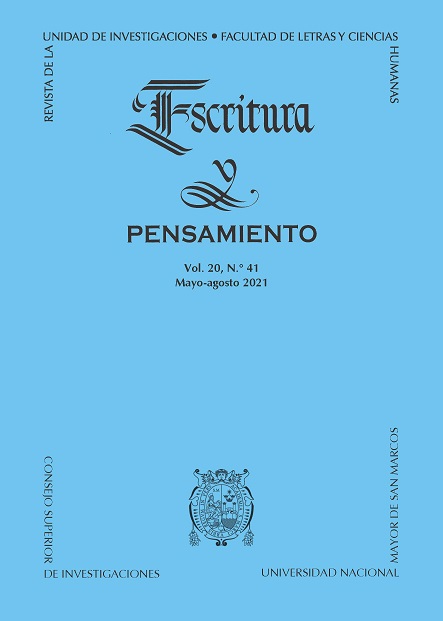La Tea: The modernization process of Peruvian poetry as a rhizome
DOI:
https://doi.org/10.15381/escrypensam.v20i41.21123Keywords:
La Tea, Peruvian poetry, modernism, postmodernism, rhizomeAbstract
The present article deals with La Tea, a magazine from Puno that was active between the horizon of modernism and the beginning of the literary avant-gardes. The hypothesis we try to prove is the following: in La Tea exists a germinal rhizomatic dynamic that takes part in the process of modernization of Peruvian poetry. For that matter, we are going to analyze the variations on the poetic discourse, since we hold that these texts move among modernism, postmodernism and, even, present some codes from the avant-garde movement. To this effect, we are going to apply the concept of rhizome proposed by Gilles Deleuze and Félix Guattari, to understand the displacement, disagreement, breakage and the dialogue that these periods develop.
References
Bosshard, M. Th. (2014). Churata y la vanguardia andina. Lima: Centro de Estudios Literarios Antonio Cornejo Polar & Latinoamericana.
Burgos, F. (1985). La novela moderna hispanoamericana (un ensayo sobre el concepto literario de modernidad). Madrid: Orígenes.
Cáceres Monroy, L. (1973). Tres Representantes del Indigenismo en Puno. (Tesis para optar el grado de Doctor en Letras-Castellano-Literatura). Universidad San Antonio Abad del Cusco. Facultad de Letras, Cusco.
Calcín Anco, R. (1999). Churata: profeta del ande. Puno: Biblioteca Popular Transparencia.
Callo Cuno, D. (1988). Dos revistas de la vanguardia regional del Sur 1917-1930 (Análisis histórico-crítico). (Tesis para optar el grado de Bachiller en Literatura y Lingüística). Universidad Nacional de San Agustín de Arequipa. Facultad de Filosofía y Humanidades, Arequipa.
Deleuze, G. & Guattari, F. ([1988] 2002). Introducción: rizoma. En Mil mesetas. Capitalismo y esquizofrenia (pp. 9-32). Valencia: Pre-Textos.
Esteba Flores, H. (2013). La prensa en Puno. Puno: Universidad Nacional del Altiplano.
La Tea (1917-1919). 12 números. Puno: El Departamento/Fournier.
Le Corre, H. (2001). Poesía hispanoamericana posmodernista. Historia, teoría, prácticas. Madrid: Gredos.
Mamami Macedo, M. (2013). Ahayu-Watan: Suma poética de Gamaliel Churata. Lima: Universidad Nacional Mayor de San Marcos & Pakarina.
Mamami Macedo, M. (2021). Chirapu: revista zurda-andina. En Luis Apaza Calizaya (ed.), Chirapu. Edición facsimilar (pp. xxi-xxxiii). Lima: Universidad Ricardo Palma.
Monasterios Pérez, E. (2015). La vanguardia plebeya del Titikaka. Gamaliel Churata y otras beligerancias. Lima/La Paz: IFEA/Plural.
Pulido Herráez, B. (2017). El Boletín Titikaka y la vanguardia anadina. México D. F.: Universidad Autónoma de México.
Ramos, A. (2016). Ezequiel Urviola y el indigenismo puneño. Tormenta Altiplánica, Rumi Maqui y la Rebelión de Huancané. Lima: Congreso del Perú.
Ramos, J. ([1989] 2009). Desencuentros de la modernidad en América Latina. Literatura y política en el siglo xix. Caracas: El perro y la rana.
Schulman, I. (2002). El proyecto inconcluso: la vigencia del modernismo. México D. F.: Siglo xxi.
Tamayo Herrera, J. (1982). Historia social e indigenismo en el Altiplano. Lima: Treintaitrés.
Tauro del Pino, A. (1993). Catálogo de seudónimos peruanos. Lima: Ariel, Comunicaciones para la Cultura.
Usandizaga, H. (2012). Introducción. En Gamaliel Churata, El pez de oro (pp. 11-143). Madrid: Cátedra.
Velásquez Garambel, J. L. (s/f). Indigenismo, Orkopata y Gamaliel Churata (Aproximación). Recuperado de https://es.scribd.com/doc/57398163/Orkopata-Indigenismo-y-Gamaliel-Churata [Consulta: 28 de febrero de 2021].
Vilchis Cedillo, A. (2013). Travesía de un itinerante. Puno: Universidad Nacional del Altiplano.
Williams, R. ([1977] 2000). Dominante, residual y emergente. En Marxismo y literatura (pp. 143-149). Barcelona: Península.
Downloads
Published
Issue
Section
License
Copyright (c) 2021 Sergio Luján Sandoval

This work is licensed under a Creative Commons Attribution 4.0 International License.
AUTHORS RETAIN THEIR RIGHTS:
a. The authors retain their trademark and patent rights, and also over any process or procedure described in the article.
b. The authors retain the right to share, copy, distribute, execute and publicly communicate the article published in the Escritura y Pensamiento (for example, place it in an institutional repository or publish as part a book), with acknowledgment of its initial publication by Escritura y Pensamiento.
c. Authors retain the right to make a subsequent publication of their work, to use the article or any part of it (for example: a compilation of their work, lecture notes, thesis, or for a book), provided that they indicate the source of publication (authors of the work, journal, volume, number and date).





